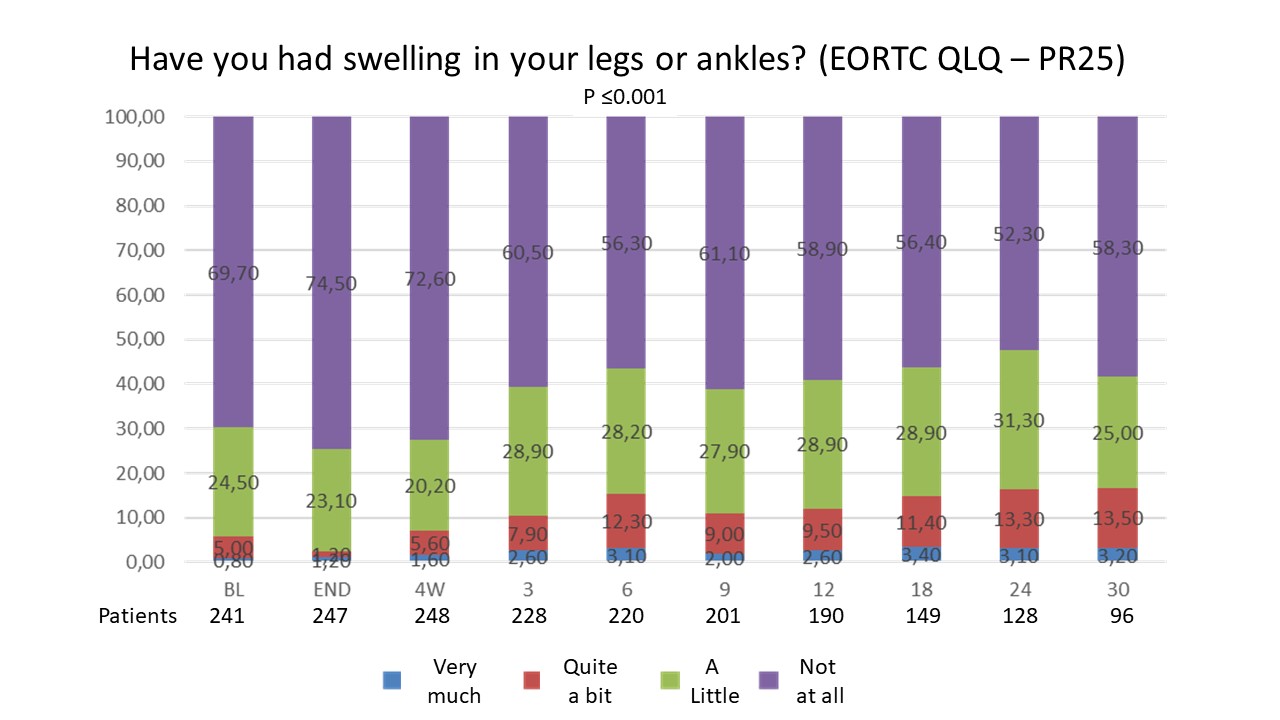Patient reported lower limb edema after curative radiotherapy for prostate cancer
PD-0571
Abstract
Patient reported lower limb edema after curative radiotherapy for prostate cancer
Authors: Lars Fokdal1, Martin Berg2, Ahmed Zedan1, Henrik Dahl Nissen2, Lise Bentzen1, Mette Svensson1, Christine Vestergaard Madsen1
1Vejle Hospital, Department of Oncology, Vejle, Denmark; 2Vejle Hospital, Radiotherapy Research Team, Department of Oncology, Vejle, Denmark
Show Affiliations
Hide Affiliations
Purpose or Objective
Lower limb edema (LLE) is a known side effect to pelvic radiotherapy (RT). The present study provides a descriptive analysis of patient reported LLE in a cohort of prostate cancer patients treated with curative RT. Moreover, the impact of elective pelvic lymph node irradiation and other risk factors for LLE are analyzed.
Material and Methods
A total of 340 prostate cancer patients treated with RT with or without androgen deprivation therapy (ADT) were enrolled in a prospective registration study in our department from 2017 to 2022. Disease outcomes, physician assessed morbidity and patient reported outcomes were recorded at baseline and during 5-years of follow-up. Patient reported LLE was assessed by use of EORTC QLQ-PR25.
Information regarding patient reported LLE was available in 310 patients. These patients were included in the study. RT was prescribed according to risk group. Patients with low to intermediate-risk prostate cancer were treated with 60 Gy/20 fx or 78 Gy/39 fx to the prostate alone. Patients with high-risk disease were treated with 56 Gy/39 fx to the pelvic lymph nodes and seminal vesicles and a simultaneous integrated boost to the prostate alone (≤T3a) or prostate and seminal vesicles (T3b) with 78 Gy/39 fx.
Descriptive analysis of LLE was done with the calculation of prevalence rates at baseline and during each follow-up visit and with Kaplan-Meier statistics. Risk factors for LLE were analyzed univariate and multivariate with Cox regression analysis. These risk factors included age, ADT, surgical lymph node staging, Body Mass index (BMI), Charlson comorbidity index (CCI), and WHO performance status (PS).
Results
In the present study, 266 (85.8%) patients were treated with RT to the prostate, seminal vesicles and elective lymph nodes. The remaining 44 (14.2%) patients were treated with RT to the prostate alone.
At a median follow-up of 15 (3-51) months, 49 (15.8%) patients had reported “quite a bit” of LLE while 21 (6.7%) patients reported “a lot” of LLE. The baseline prevalence rate of “quite a bit” and “a lot” of LLE was 5.0% and 0.8%, respectively. During follow-up the prevalence rate for “quite a bit” or “a lot” of LLE increased significantly to reach a plateau after 12 months follow-up where 9.0-13.5% and 2.0-3.4% of the patients reported “quite a bit” and “a lot” of LLE, respectively (figure 1).
Risk factors for LLE in univariate analysis (elective lymph node irradiation (p=0.069), BMI (p<0.001), CCI (p=0.036), PS (p=0.091)) were analyzed in multivariate analysis. Only BMI (p=0.002) remained significantly associated with an increased risk for LLE after RT for prostate cancer (table 1).

Figure 1. Patient reported lower limb edema at baseline and during follow-up

Table 1. Univariate and multivariate analysis
Conclusion
Severe patient reported LLE after curative RT for prostate cancer is rare. However, there is a risk of mild to moderate LLE especially in patients with a high BMI. These findings warrant an active rehabilitation program after RT for prostate cancer.